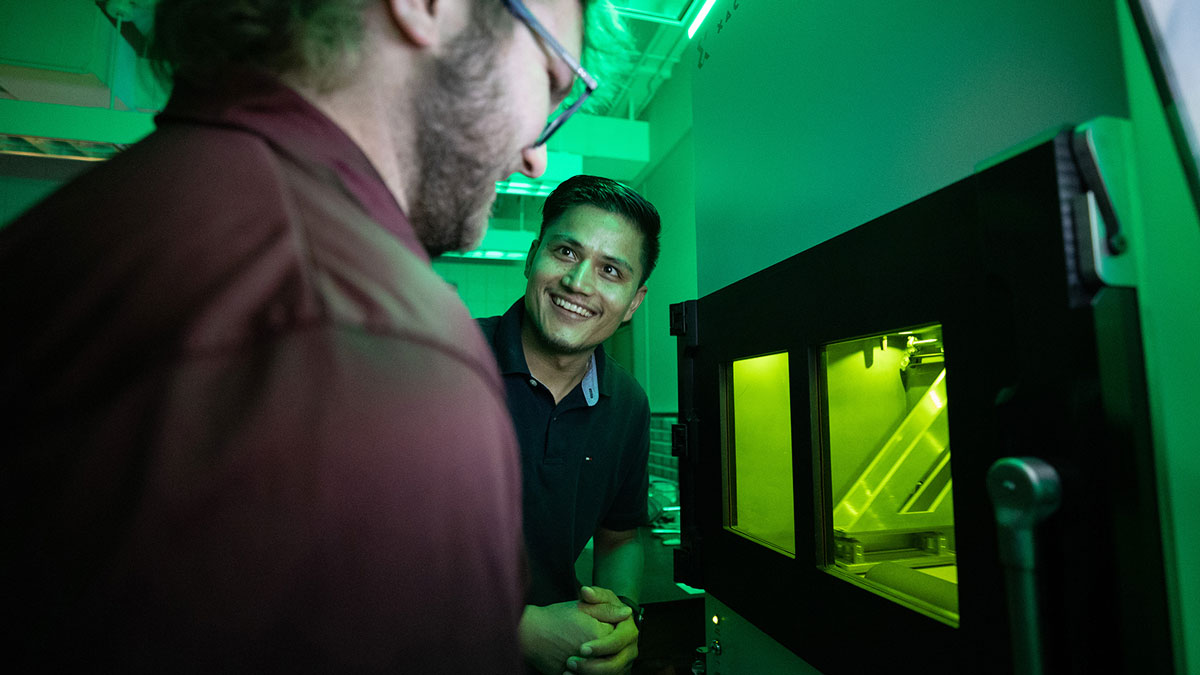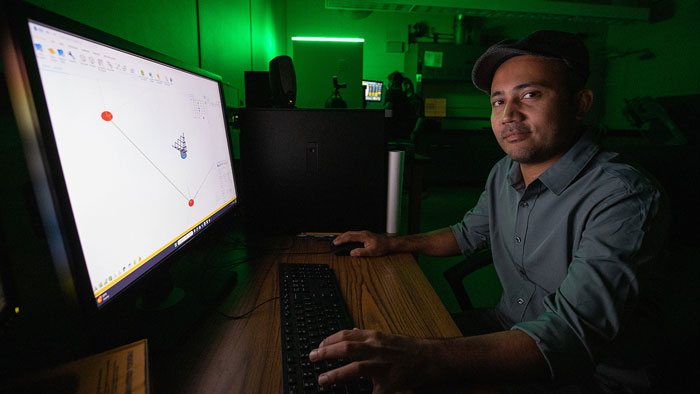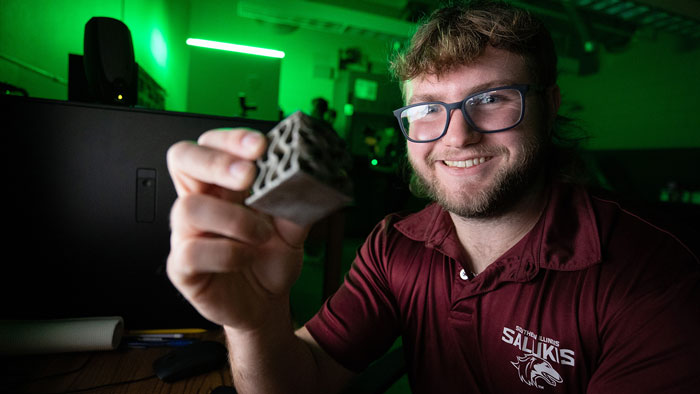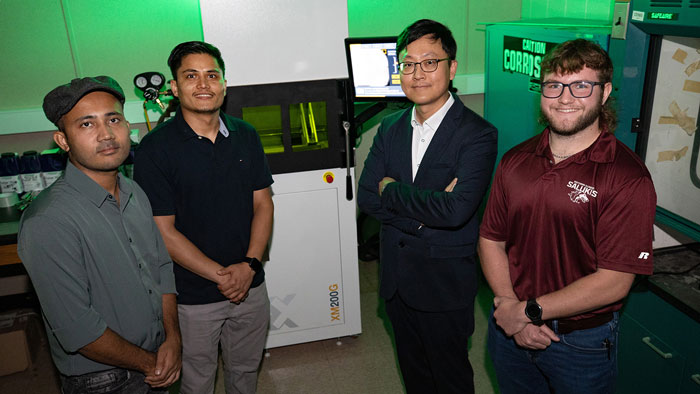
(Top) Mechanical engineering master’s students Reese Rodely (left) and Kamal Kunwar discuss what they are observing in SIU Carbondale’s 3D metal printer. (Second photo) Doctoral student Himal Sapkota prepares data and sets up builds for 3D printing. (Third photo) Rodely shows a 3D-printed lattice structure. (Fourth photo) Assistant professor Sangjin Jung (second from right) and his students gather in the lab. Their work is an example of what makes SIU Carbondale a Research 1 university. (Photos by Russell Bailey)
October 09, 2025
SIU researcher aims to make 3D-printed metal parts more robust — and strengthen trust in the tech
CARBONDALE, Ill. — To many, 3D printing evokes images of desktop gadgets spitting out plastic trinkets. In reality, additive manufacturing (AM) now builds metal components for aircraft engines, medical devices and other intricate parts not easily made with traditional methods. The catch? Tiny, hard-to-avoid defects in printed metals can weaken parts and erode manufacturer confidence. Southern Illinois University Carbondale professor Sangjin Jung is tackling that reliability problem head-on.
With a new $200,000 National Science Foundation Engineering Research Initiation grant, Jung’s two-year project focuses on designing metal parts that stay strong even when small defects inevitably occur — so companies can trust what comes off the printer.
“Real production isn’t perfect,” Jung said. “Instead of pretending defects don’t happen, we build them into the design process and make the part robust anyway.”
Jung brings a blend of industry and academic experience to the work. Before joining SIU in 2021 as an assistant professor in the School of Mechanical, Aerospace, and Materials Engineering, he served as a senior research engineer at LG Electronics’ Production Engineering Research Institute and as a research scientist at both Carnegie Mellon University and Pennsylvania State University.
Why AM matters — and where it shines
“One of AM’s biggest advantages is design freedom,” Jung said, noting that the grant can help position SIU and regional businesses as a hub for additive manufacturing.
Unlike traditional machining, which often limits shapes, AM can create highly complex, lightweight geometries that would be impossible — or prohibitively expensive — otherwise. It’s also material-efficient because parts are built layer by layer, generating far less scrap than cutting from a solid block. Add rapid prototyping and localized production, and AM can shorten supply chains while speeding the path from idea to finished part.
These strengths already power sectors that need custom, high-performance components: aerospace and automotive for weight reduction and fuel efficiency, medical for patient-specific implants and prosthetics, and defense and energy for complex, high-duty parts.
“In all these cases,” Jung said, “the ability to create tailored, intricate geometries gives AM a clear advantage over traditional methods.”

The problem: microscopic defects
AM part defects can spring from many sources — laser power, scan speed, hatch spacing, recoater wear or even powder quality. These flaws don’t always show up the same way, which makes performance unpredictable. Current design methods often assume defect-free parts, optimize the geometry and only then discover real-world issues during testing.
Jung’s approach flips that script. His team will model the likelihood and impact of defects inside their simulations, then optimize the design to be defect-tolerant from the start. The goal: reduce trial-and-error in the lab and deliver parts that perform reliably in real manufacturing conditions.
The potential payoff is big. The global AM market is projected to grow to $100 billion by the early 2030s, but that growth depends on proving consistent, certifiable performance at scale. If designs can tolerate real-world variability, manufacturers can move more parts from pilot runs to true serial production — and do it with confidence.

What it means for students, courses, labs — and local industry
The grant strengthens SIU’s design for additive manufacturing (DFAM) capabilities by leveraging the university’s metal 3D-printing facilities. Students will work on interdisciplinary projects that blend simulation, optimization and hands-on printing, gaining experience that translates directly to industry needs. Lessons learned will flow into DFAM-related curricula, modernizing courses and labs.
Partnerships are central. The team plans workshops and applied projects with local companies, opening doors for capstone collaborations and internships. The result is a talent pipeline for Southern Illinois industries exploring advanced manufacturing — and a clearer route for companies to apply Jung’s research to real AM production problems.
“The research simulates how real-world defects affect performance and then refines the design accordingly,” Jung said. “This will dramatically cut costly experimental iterations while producing designs that align with real manufacturing conditions.”

What success looks like
If the approach works as planned, it could shift AM’s reputation — from a promising tool that sometimes disappoints to a reliable production technology that consistently yields defect-tolerant parts. That boost in trust could accelerate adoption over the next decade, moving AM from niche use to a mainstream manufacturing strategy, especially for complex, lightweight designs where it already excels.
Bottom line
SIU’s goal is simple and ambitious: design resilience into metal AM from day one, unlock certifiable performance at scale and graduate engineers ready to help manufacturers print — reliably, repeatably and with confidence.
